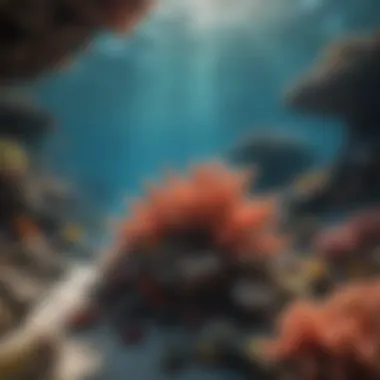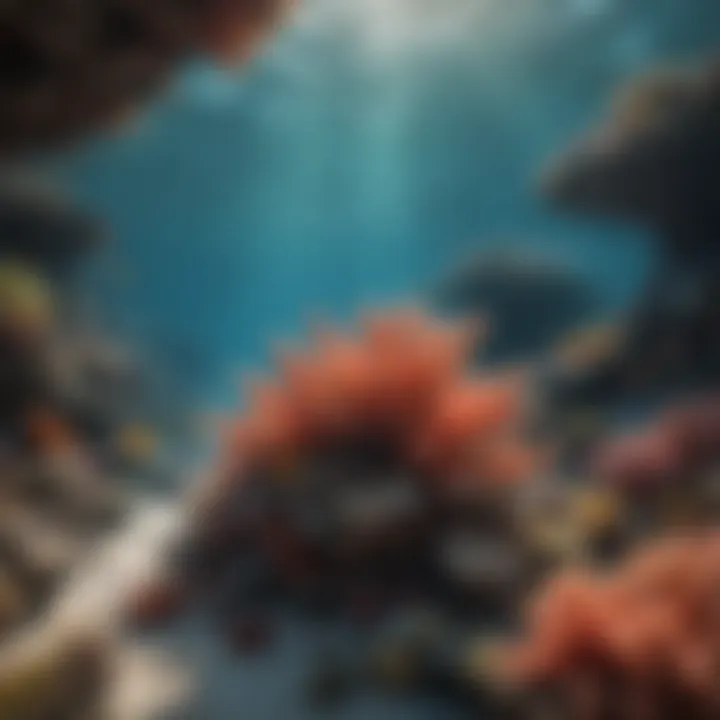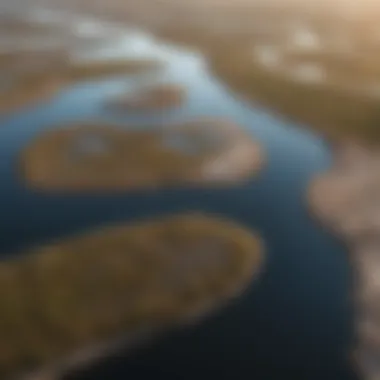Exploring the Saltwater Ecosystem: A Detailed Study


Intro
Saltwater ecosystems stand as some of the most dynamic and diverse environments on our planet. From the vibrant coral reefs to the vast, mysterious depths of the ocean, these habitats host a rich tapestry of life forms, play a crucial role in global climate regulation, and support human activities depending on their resources. Yet, understanding the complexities of these ecosystems requires not only a grasp of their inhabitants but also an appreciation of the delicate balance they maintain with abiotic factors like salinity, temperature, and nutrient availability.
This article dives into the intricate weave of saltwater ecosystems, highlighting how various life forms interact within their environments and the ecological processes that sustain them. While exploring the beauty and significance of these systems, we also address the pressing threats they face – from climate change to pollution. Moreover, we'll discuss ongoing conservation efforts and research innovations aimed at protecting these vital habitats for the benefit of future generations.
By equipping readers with a deeper understanding of saltwater ecosystems, the narrative aims to foster a sense of stewardship and urgency, prompting concern for the preservation of these invaluable resources. \n
Recent Advances
Saltwater ecosystems are witnessing a period of significant transformation driven by environmental change and human influences. To stay ahead, scientists are implementing new strategies to monitor and protect these systems.
Latest Discoveries
Recent explorations have uncovered unexpected resilience within certain marine communities. For example, some coral species have shown remarkable adaptability to rising ocean temperatures, indicating potential pathways for reef survival in a changing climate. Additionally, breakthroughs in the study of symbiotic relationships, such as those between corals and algae, have refined our understanding of nutrient cycling and energy transfer in these ecosystems.
Furthermore, deep-sea explorations have revealed previously unknown species, underscoring the urgent need to study and protect marine biodiversity before it can be lost forever. Research at sites like the Mariana Trench provides insights into adaptations to extreme environments, shedding light on the evolutionary processes at play in saltwater habitats.
Technological Innovations
The application of technology has played a pivotal role in advancing our understanding of saltwater ecosystems. Innovations such as remote sensing and underwater drones allow researchers to monitor ecological health and track changes in habitat conditions efficiently. Scientists are now using these tools to:
- Assess coral bleaching events in real time
- Map and analyze habitat changes due to human impacts
- Gather data on fish populations to inform sustainable fisheries management
Incorporating these technologies has vastly improved data accuracy and accessibility, paving the way for more effective conservation strategies.
Methodology
Understanding our saltwater ecosystems necessitates a structured approach to research, ensuring that findings are both reliable and applicable. A comprehensive examination involves meticulous planning and execution in both research design and data collection techniques.
Research Design
Research in saltwater ecosystems often employs a multi-tiered approach, combining both field studies and laboratory analyses. Scientists may start with broad observational studies to track trends over time, followed by focused experiments to test specific hypotheses. These studies often involve partnerships across disciplines, merging insights from marine biology, ecology, and environmental science.
Data Collection Techniques
Various methods are used for gathering data in saltwater ecosystems, including:
- Field Surveys: Direct observations and species counts provide baseline data for ecological assessments.
- Remote Sensing: Satellites capture large-scale environmental data, vital for monitoring habitat health and changes.
- Laboratory Analyses: Controlled experiments help to understand the physiological responses of marine organisms to stressors like temperature fluctuations.
Each technique offers unique insights, allowing researchers to build a comprehensive view of the nuances within these ecosystems.
"In scientists' hands, data is no longer just numbers; it becomes a window into the health of our oceans and a call to protect them."
These methods highlight the importance of interdisciplinary approaches and the need for collaboration in tackling the complex challenges confronting saltwater ecosystems today.
Preface to Saltwater Ecosystems
Saltwater ecosystems are the vast, diverse habitats that form the backdrop of our oceans, covering more than 70% of the Earth’s surface. These systems are not just a collection of salts and water; they are vibrant communities teeming with life and intricate interactions that hold immense significance for our planet. Within this article, we will navigate through the multifaceted aspects of saltwater ecosystems. By understanding their structure, function, and the relationships among biotic and abiotic components, we can appreciate their crucial role in the global biosphere.
Definition and Scope
A saltwater ecosystem, often referred to as a marine ecosystem, encompasses all forms of life found in the oceans, seas, and other saltwater bodies. The variety here ranges from the microscopic phytoplankton floating on the surface to the majestic blue whales gliding through the depths.
The scope of these ecosystems extends beyond just the organisms living in them; it also includes the physical and chemical components of seawater, such as salinity, temperature, and nutrient availability. Each of these factors interacts to shape the life forms and the processes that occur within the ecosystem, creating a rich tapestry of life that can adapt and thrive in varying conditions. The study of saltwater ecosystems is not just an academic pursuit; it has practical implications for fisheries, conservation efforts, and climate studies.
Importance of Saltwater Ecosystems
Saltwater ecosystems are pivotal to the health of our planet and human existence. They perform numerous essential functions:
- Biodiversity Hotspot: These ecosystems host a staggering diversity of species, many of which have not yet been documented, contributing to global biodiversity.
- Carbon Sequestration: Marine plants, particularly seagrasses and mangroves, absorb carbon dioxide, helping to mitigate climate change.
- Fisheries Source: They are crucial for industry, providing food and livelihood for millions around the world.
"Saltwater ecosystems are not merely a source of beauty; they are a lifeline for countless creatures, including humans. Their health and stability are intricately linked to our survival."
Yet, these ecosystems are under threat from human activities such as pollution, overfishing, and climate change. Protecting and preserving these habitats is not just an environmental concern; it’s a necessity for sustaining life both in the oceans and on land. By understanding the importance of saltwater ecosystems, we better equip ourselves to advocate for their protection on multiple fronts.
In upcoming sections, we will delve deeper into the characteristics, biotic components, and the pressing human impacts on these vital systems.
Characteristics of Saltwater Ecosystems
Understanding the characteristics of saltwater ecosystems is essential not just for scientific inquiry but also for the maintenance and conservation of these vital natural resources. Saltwater ecosystems, which encompass oceans, seas, and estuaries, are subject to unique environmental factors that govern their structure and function. Recognizing these characteristics helps in comprehending the intricate interactions between various organisms and their environment, providing insight into their ecological roles and the impact of human activities. Key elements such as salinity, water depth, light penetration, and temperature gradients are essential not only for marine life but also for the health of the global biosphere.


Salinity and its Variations
Salinity is the measure of all the salts dissolved in water, and it plays a crucial role in the distribution and abundance of marine organisms. Salt content varies significantly across different regions and depths of the ocean due to various factors like evaporation, precipitation, river inflow, and ocean currents.
- Coastal Areas: Generally, salinity is lower here due to freshwater influx from rivers and rainfall. These areas support diverse biological communities.
- Open Ocean: In contrast, the open ocean typically maintains higher salinity levels with minimal fluctuation. This uniformity supports specialized species adapted to life in those greater salt concentrations.
The variations in salinity impact osmoregulation in marine life. For example, fish in estuarine habitats often face fluctuating salinity levels, making them adaptable yet vulnerable to environmental changes. Therefore, understanding salinity helps researchers predict how marine species may respond to climate change and pollution, both of which can alter saline conditions.
Water Depth and Light Penetration
Water depth is another essential characteristic of saltwater ecosystems that determines the distribution of organisms based on their light requirements. Light penetration in water diminishes with depth, impacting photosynthesis and the subsequent food chain.
- Photic Zone: The upper layer, where sunlight penetrates, typically goes down to about 200 meters. Here, photosynthetic organisms like phytoplankton thrive, fueling the entire marine food web.
- Aphotic Zone: Beyond this depth, light is nearly absent, leading to unique adaptations among organisms. Some creatures can produce bioluminescence, highlighting the diverse strategies life employs to survive in complete darkness.
This relationship between water depth and light affects not only biological productivity but also various ecological processes, highlighting the critical role light plays in sustaining marine ecosystems.
Temperature Gradients
Temperature gradients in saltwater ecosystems reveal the stratification of waters, significantly influencing marine life. The upper layer, known as the epipelagic zone, remains warmer due to direct sunlight exposure. However, as one descends into the ocean, the temperature drops markedly.
- Thermocline: This is the layer where water temperature declines rapidly with depth. It bursts of life, with abundant phytoplankton in the warm upper layers making it critical for energy transfer through the food web.
- Cold Deep Waters: Below the thermocline, temperatures can hover just above freezing, heavily influencing fish distribution and migratory patterns.
These thermal gradients also affect the solubility of gases like oxygen, which is essential for respiration in aquatic life. Warmer waters tend to hold less oxygen, meaning that the health of marine ecosystems may be jeopardized as ocean temperatures continue to rise.
"The factors of salinity, depth, and temperature are interconnected threads that compose the fabric of saltwater ecosystems. Understanding them is crucial for examining the health of our oceans."
Biotic Components of Saltwater Ecosystems
The biotic components of saltwater ecosystems form the living fabric that sustains marine life and maintains the overall health of these environments. Understanding these components is crucial, as they encompass various organisms that play unique roles, from the microscopic phytoplankton to large marine mammals. These diverse life forms interact in complex ways, creating a web of life that supports a myriad of ecological processes. The significance of studying biotic components lies in comprehending how these relationships function and the implications for underwater biodiversity, climate regulation, and human interaction with the oceans.
Primary Producers
Phytoplankton
Phytoplankton are the unsung heroes of the ocean, often overlooked but vital for marine ecosystems. These microscopic plants thrive in sunlit surface waters, where they harness solar energy through photosynthesis. Their role in the food web is foundational; they produce about half of the world's oxygen and form the base of aquatic food chains. Their ability to rapidly reproduce makes them pivotal in nutrient cycling, particularly in nutrient-rich upwelling zones.
One striking characteristic of phytoplankton is their remarkable diversity, encompassing thousands of species, including diatoms, dinoflagellates, and cyanobacteria. However, they also face challenges, particularly from environmental changes. Increased water temperatures and nutrient loading can lead to harmful algal blooms, which can cause dead zones—areas with depleted oxygen levels that are inhospitable to most marine life. Monitoring phytoplankton populations is thus essential for assessing the overall health of marine ecosystems and predicting changes that may arise from anthropogenic pressures.
Macroalgae
Moving to larger organisms, macroalgae, often called seaweeds, are another vital group of primary producers in saltwater ecosystems. These macroscopic plants provide critical habitat and food for a wide range of marine creatures, from fish to sea urchins. Species like kelp form underwater forests, creating rich environments that support diverse marine life. Macroalgae contribute not only to habitat but also stabilize coastlines and help in carbon sequestration, a crucial function in mitigating climate change.
A key characteristic of macroalgae is their adaptability to different environments, whether it's the intertidal zones where they withstand crashing waves or the deeper areas where light penetration decreases. However, macroalgae are also affected by pollution and ocean acidification, which can alter their growth patterns. While they offer many benefits, their overgrowth can indicate nutrient pollution in coastal waters, highlighting the need to balance their presence in ecosystems.
Consumers
Consumers in saltwater ecosystems range from tiny zooplankton to massive whales, and they all play integral roles in maintaining ecological balance.
Herbivores
Herbivores, like sea turtles and certain fish species, graze on primary producers such as phytoplankton and macroalgae. Their grazing not only helps control plant populations but also promotes nutrient cycling by breaking down plant material into biomass that can be recycled by decomposers. One notable aspect of herbivores is their role in maintaining the health of coral reefs. By eating algae, they help prevent harmful overgrowth that can smother coral.
However, herbivores face mounting threats from habitat loss and overfishing, which can disrupt the very ecosystems they help to regulate. For instance, the decline of grazing species in a coral ecosystem can result in unchecked algal proliferation, leading to reef degradation.
Carnivores
Carnivores, including sharks and predatory fish, maintain the balance by controlling herbivore populations and ensuring no single species dominates the ecosystem. They contribute to the biodiversity and health of an ecosystem through predation, which helps maintain healthy populations of various organisms.
The unique feature of carnivores is their position at the top of the food chain, allowing them to influence the entire ecosystem's structure. Yet, they are under threat from overfishing and habitat destruction, leading to an imbalance that can have cascading effects on marine life and habitats.
Omnivores
Lastly, omnivores occupy a versatile space in marine ecosystems, consuming both plant and animal matter. Species like sea otters and some fish are pivotal in maintaining balance by consuming various dietary sources, contributing to energy transfer and nutrient cycling.
Their adaptability is a key advantage as they can exploit fluctuating resources. However, like other consumers, they are affected by habitat changes and human activities, making their study essential for understanding ecosystem dynamics and resilience.
Decomposers and their Role
Decomposers, including bacteria, fungi, and some invertebrates, are the unsung custodians of saltwater ecosystems. Their vital role in breaking down dead organic material recycles nutrients back into the environment, maintaining the ecosystem's productivity. Without decomposers, organic matter would accumulate, leading to an imbalance that could affect all organisms within the ecosystem.
By facilitating the breakdown of complex organic compounds, decomposers contribute to nutrient cycling, which is necessary for the survival of primary producers. They are often overlooked yet are indispensable to the well-being of marine ecosystems. Changes in their populations can signal shifts in environmental health, emphasizing their importance in monitoring marine ecosystems.


Overall, the biotic components of saltwater ecosystems underscore the intricate relationships that sustain marine life. From the foundational producers to the crucial consumers and decomposers, each group plays a vital role that contributes to the richness and diversity of oceanic environments.
Abiotic Factors Influencing Saltwater Ecosystems
Understanding abiotic factors is an essential part of exploring the complexities of saltwater ecosystems. These factors serve as the non-living components that interact with biotic elements, shaping the overall function and health of marine environments. Abiotic influences encompass various elements like nutrient availability, ocean currents, and geological features, all of which play pivotal roles in determining the characteristics and productivity of these ecosystems. It's crucial for both conservation efforts and scientific research to account for these components to gain a complete picture of marine ecology.
Nutrient Availability
Nutrient availability is a cornerstone of saltwater ecosystems. Without proper nutrients, the vibrancy of marine life suffers greatly. Salts, nitrogen, phosphorus, and trace minerals are essential for the growth of primary producers such as phytoplankton and macroalgae. These tiny but mighty organisms form the base of the food web, supporting everything from small fish to massive whales.
In some areas, nutrient levels fluctuate due to natural phenomena, like upwelling zones where deeper, nutrient-rich waters rise to the surface. However, human activities, including agricultural runoff and wastewater discharge, have significantly altered the delicate balance of nutrient distributions.
"Nutrient overload can lead to algal blooms that block sunlight and deplete oxygen, creating dead zones where marine life cannot survive. This cycle indicates a stark reality: balance is key in the ocean's chemistry."
Ocean Currents and Their Effects
Next, we look at ocean currents, which act like highways in saltwater ecosystems. These currents are driven by wind patterns, water temperature gradients, and the Earth’s rotation. They significantly influence climate, nutrient distribution, and even migration patterns for various marine species. Some currents bring warm water north, which affects the species found in those regions. On the other hand, cold currents can create habitats that support unique ecosystems distinct from warmer locales.
Moreover, currents also play a role in dispersing larval organisms and nutrients. When currents are disrupted due to climate change or human interference—like damming rivers or coastal development—the entire marine tapestry can suffer, which alters biodiversity and ecosystem resilience.
Geological Features
Last but certainly not least, geological features shape the physical landscape of saltwater ecosystems. From beautifully diverse coral reefs to daunting underwater canyons, these structures create environments that support a multitude of marine life. Coral reefs, for example, offer habitats rich in biodiversity. The intricacies of reef formations foster homes for countless species, making them hotspots of marine life.
On the flip side, features like rocky shorelines can be harsh and limit the types of organisms that thrive there. Sediment composition, ocean floor topography, and other geological elements can influence water chemistry and how organisms interact with their environment. Understanding these formations allows researchers to predict and mitigate the impact of changes within marine ecosystems.
Ecological Interactions in Saltwater Ecosystems
Ecological interactions form the backbone of saltwater ecosystems. These interactions not only dictate how various species coexist but also influence the overall health of marine environments. Understanding these elements is crucial because they hold the key to ecological balance and biodiversity. As the saying goes, "it takes a village," and in our case, it takes diverse species working together to maintain the delicate equilibrium in these waters.
Food Web Dynamics
Food webs illustrate the complex feeding relationships between different organisms in saltwater habitats. They are interconnected networks that show who eats whom, creating a predictable flow of energy throughout the ecosystem. For example, phytoplankton serves as primary producers, providing energy to herbivores like small fish, which, in turn, become prey for larger carnivores such as sharks or tuna.
To visualize the impact of these interactions, consider this: if one species is removed from the web, it can disrupt the entire system. Imagine plucking a single thread from a spider’s intricate web; the whole structure may sag or even collapse.
The concept of the food web emphasizes how every species plays a role – no matter how big or small. Moreover, these dynamics are not static; they shift based on environmental changes, seasonality, and human impact, such as fishing pressures and pollution. Predators help keep herbivore populations in check, preventing overgrazing of primary producers and ensuring a balance where multiple species can thrive.
Symbiotic Relationships
Symbiotic relationships represent a unique aspect of life in saltwater ecosystems. These interactions can be characterized in three distinct types: mutualism, commensalism, and parasitism.
Mutualism
Mutualism in saltwater habitats is a classic win-win scenario. Take the cleaner shrimp and the fish that rely on them. The shrimp benefit by gaining access to food when they eat parasites off the fish, while the fish enjoy reduced parasite loads. It’s a partnership built on trust!
Each participant in mutualism gains advantageous benefits. This relationship helps maintain fish health and diversity, ultimately contributing to a more stable marine environment. However, it’s important to note that if one party falters, the other may suffer as well. Such dependencies highlight the fragility of these interdependencies; they are beneficial but carry a risk of imbalance.
Commensalism
Commensalism is interesting in that one organism benefits while the other remains unaffected. An example can be found in barnacles that adhere to a whale. The barnacles gain mobility to nutrient-rich waters, while the whale hardly notices. This dynamic plays into the efficiency of nutrient cycling in marine ecosystems.
Despite its seemingly harmless nature, commensalism can influence local biodiversity. By increasing the number of organisms that benefit from a host, it could lead to changes in feeding patterns and habitat usage. However, be wary—what may seem trivial to one organism could significantly impact another, complicating the overall dynamics.
Parasitism
Parasitism often gets a bad rap, yet it serves a role in the intricate tapestry of saltwater life. A striking example includes the parasitic isopods that embed themselves within a fish’s mouth. The isopod takes a meal from the fish, often affecting its overall health. This interaction directly influences fish populations and community dynamics.
In many ways, parasites can even act as population control agents. They can create pressure on the host species, fostering resilience and adaptation. Yet the downside of this relationship cannot be ignored; heavy infestations can lead to weakened populations, which in turn may impact predators higher in the food chain.
Exploring these ecological interactions forms a greater understanding of how life intertwines in saltwater environments. They reveal the balance of cooperation and competition, shaping the marine landscapes we seek to conserve.
Human Impact on Saltwater Ecosystems
Human activities have dramatically altered saltwater ecosystems across the globe. As these habitats are vital to not only marine life but also to human existence, understanding their fragility and the impacts of our actions is crucial. The coastal areas, oceans, and seas which make up saltwater ecosystems serve as essential resources—for food, commerce, and recreation. Yet, they are under siege from a myriad of human-induced pressures.
Pollution and Its Consequences
Pollution in saltwater ecosystems manifests in various forms, affecting both the creatures that dwell there and the overall health of the marine environment. One of the most pressing issues is the runoff from agricultural lands, which carries fertilizers and pesticides into the oceans. This leads to eutrophication, a process that results in excessive growth of algae at the water's surface, sparking the creation of dead zones where little to no aquatic life can thrive regardless of other surrounding biological richness.
Floating plastic waste presents another dire scenario, as it is not just an eyesore but a long-term threat to marine life. According to studies, nearly every species of seabird has been found with plastic in their stomachs. Marine turtles and fish, often mistake plastic bags for their prey, leading to their slow demise. The chemical pollutants in the water can bioaccumulate through the food web, posing risks not just to marine life, but also to human health given the reliance on seafood as a food source.


"Pollution is like a ticking time bomb for our oceans; one that can disrupt the very fabric of marine ecosystems."
Overfishing and Biodiversity Loss
Overfishing is often likened to a slow bleed on the marine biodiversity that saltwater ecosystems rely upon. It's a double-edged sword: not only does it deplete certain fish stocks, it disrupts the intricate balance of the food web, resulting in cascading effects that harm diverse species. Species like cod and tuna have seen their populations plummet due to unsustainable fishing practices. When top predators are removed, prey populations can explode, leading to severe imbalances.
This situation is made worse when smaller fish populations decline, as many larger marine animals depend on them for food. A decline in biodiversity can have profound effects on the resilience of an ecosystem, making it more susceptible to disease and changing climatic conditions. The benefits of maintaining biodiversity extend beyond ecosystem health; they are directly tied to human health as well, relying on a stable food supply and ecosystem services.
Climate Change Effects
The repercussions of climate change are trickling down into saltwater ecosystems in complex and profound ways. Warming oceans affect species migration patterns and breeding cycles, forcing fish to seek cooler waters. Coral reefs, often dubbed the rainforests of the sea, are particularly vulnerable. Increased water temperatures and acidification spell doom for coral systems, leading to widespread bleaching and decline.
As sea levels rise, coastal ecosystems like mangroves and salt marshes face inundation, which can lead to loss of habitat for many species. Furthermore, changes in ocean currents can alter nutrient distributions that are critical for food chains. The increased severity of weather events like hurricanes can devastate coastal habitat and allow for the encroachment of invasive species, further threatening endemic marine life.
In summary, the impact of human activities on saltwater ecosystems is profound and multifaceted. Pollution, overfishing, and climate change intertwine in a web of consequences that not only jeopardize marine biodiversity but also threaten the very resources upon which human livelihoods depend. Adaptation and mitigation strategies are needed more than ever to preserve these ecosystems.
Conservation of Saltwater Ecosystems
Conserving saltwater ecosystems holds paramount significance in today's rapidly changing environment. These ecosystems not only contribute to the planet's biodiversity but also play a critical role in regulating climate, offering fresh air to breathe and sustaining countless species—including humans. Without adequate conservation efforts, the delicate balance within these environments can be irrevocably disrupted, leading to a cascade of negative impacts that can affect human livelihoods, wildlife, and overall planet health.
Current Conservation Initiatives
Today, a plethora of conservation initiatives target the myriad challenges facing saltwater ecosystems. Many organizations and governments are stepping up to this plate, realizing that conserving marine habitats isn’t just the right thing to do; it’s essential.
Some notable initiatives include:
- Restoration Projects: These focus on rehabilitating mangroves, coral reefs, and seagrass beds that are crucial to maintaining the ecological integrity of saltwater environments. Numerous NGOs dive into action, restoring these habitats often considered the canaries in the coal mine.
- Legislative Actions: Many countries are enacting stricter regulations on fishing, coastal development, and pollution to mitigate their impacts on marine environments. For instance, the introduction of laws to limit plastic waste in oceans illustrates a step towards sustainability.
- Community Engagement: Many conservation efforts hinge on local communities. Grassroots organizations empower local populations to become stewards of their marine resources. Engaging fishermen, for example, in the conversation about sustainable practices or alternative livelihoods can yield profound results.
"Healthy oceans mean healthier lives—both for marine creatures and humankind alike."
Importance of Marine Protected Areas
Marine Protected Areas (MPAs) are a vital component of effective conservation strategies. They create sanctuaries for marine life, allowing ecosystems to recover and flourish without the constant pressures exerted by human activities. Some crucial aspects of MPAs include:
- Biodiversity Enhancement: MPAs boost biodiversity, allowing various species to thrive in a setting less impacted by human interference. This boost is critical, especially in the face of climate change.
- Fisheries Sustainability: By establishing no-take zones, MPAs can help replenish fish stocks, which are vital for commercial and subsistence fishing. When fish populations regain health in protected areas, they can even spill over into surrounding fishing grounds.
- Research Opportunities: These areas provide natural laboratories for scientists to study marine ecosystems in their pristine state, offering invaluable data that can inform broader conservation strategies. By engaging in research within MPAs, scientists can track the impacts of climate and environmental changes over time.
Future Directions in Saltwater Ecosystem Research
Research into saltwater ecosystems always has room to grow, and as challenges increase, so do the opportunities for innovation. Understanding the oceans is not just a nice-to-have; it’s essential for ensuring the future health of our planet. The importance of future research in saltwater ecosystems cannot be overstated, as it helps forge connections between ecological understanding and real-world applications. From tackling climate change to enhancing marine resource management, this field plays a pivotal role.
Technological Advances in Marine Research
Over the past few years, technology's growth has radically shifted how we study marine environments. Tools like drones, remote sensing, and autonomous underwater vehicles (AUVs) have transformed our research capabilities. These advances enable scientists to collect vast amounts of data from hard-to-reach areas, allowing for a much broader understanding of ocean health and ecosystem dynamics. The integration of artificial intelligence into data analysis presents another exciting frontier. With AI, researchers can quickly process and analyze complex datasets, unveiling patterns that human researchers might miss. This can greatly enhance monitoring efforts, making it easier to identify changes in biodiversity and environmental health.
"The ocean remains vastly unexplored, and technology is opening doors to discovering the unknown."
Additionally, scientific collaborations between institutions and industries are on the rise. When various players come together, they combine knowledge and resources, which leads to innovative solutions and more comprehensive research. Local universities, governmental agencies, and private tech firms are working side by side more than ever. This synergy can pave the way for groundbreaking studies, tools, and methods to preserve and protect saltwater environments.
Public Engagement and Education
No one can overlook the value of educating the public regarding saltwater ecosystems. Engaging communities boosts awareness and encourages a collective responsibility towards marine conservation. Educational programs and outreach initiatives can substantially increase interest in marine sciences. When people understand the direct impact of their actions on marine ecosystems, they are more likely to take steps to mitigate negative effects.
A range of platforms is being utilized to reach various audiences – social media, workshops, podcasts, and more. These can effectively draw attention to the importance of conservation efforts, such as sustainable fishing practices, pollution reduction strategies, and habitat protection measures. Schools, local communities, and public institutions can play a part by organizing informative events, seminars, and clean-up drives along coastlines.
Collaboration with scientists is also key to education efforts. Scientists can help create informative content, share their work directly with the public, and encourage local stewardship initiatives.
In summary, future directions in saltwater ecosystem research focus not just on advancing technology, but also on increasing public engagement and understanding. Both elements are crucial for ensuring marine ecosystems can thrive amidst the multifaceted challenges they face. Investing in this research is investing in our future.
Culmination
In wrapping up our exploration of saltwater ecosystems, it’s clear that these complex habitats play an integral role in maintaining the overall health of the planet. Their multifaceted nature is not merely a backdrop for marine life; rather, they actively regulate climate, support biodiversity, and contribute significantly to human livelihoods. Understanding the specifics of these ecosystems is not just an academic exercise; it brings to light the various benefits they offer, such as the provision of food, recreational opportunities, and medicinal resources.
Summary of Key Findings
Throughout the article, we highlighted several critical aspects that showcase the significance of saltwater ecosystems:
- Diversity of Life: From the smallest phytoplankton to the largest marine mammals, there is an incredible variety of species that inhabit these waters. Each plays a unique role in the ecological balance.
- Ecological Processes: The interconnectedness of organisms, such as food webs and symbiotic relationships, exemplifies the intricate dynamics at play.
- Human Impact: Overfishing, pollution, and climate change pose serious threats to these ecosystems. Recognizing these challenges is key to implementing effective conservation strategies.
- Conservation Initiatives: Various programs, including Marine Protected Areas, have been established to foster the recovery of degraded habitats. Awareness and support for these efforts can make a tangible difference.
"The health of saltwater ecosystems is paramount not just for marine species but for the entire biosphere."
The Path Forward
Looking ahead, the future of saltwater ecosystems hinges on several pivotal considerations. Firstly, continued research utilizing technological advances can shed light on the complexities of these environments. Areas such as remote sensing and genetic analysis are paving the way for more nuanced understandings of marine life.
Secondly, public engagement and education are essential. By informing communities and stakeholders about the importance of these ecosystems, we can enhance conservation efforts, promote responsible stewardship, and encourage sustainable practices. To illustrate:
- Educational Programs: Schools and community organizations can integrate marine education into their curricula, fostering a sense of responsibility and connection to ocean health among students.
- Community Engagement: Local activities, such as beach clean-ups and citizen science projects, can bridge the gap between scientific research and community involvement.
Ultimately, the survival of saltwater ecosystems is a collective challenge that requires collaboration across all sectors of society. Protecting these vital resources is not just about preserving wildlife; it’s about safeguarding our future. The path forward thus lies in a shared commitment to understanding these ecosystems and taking impactful actions.















